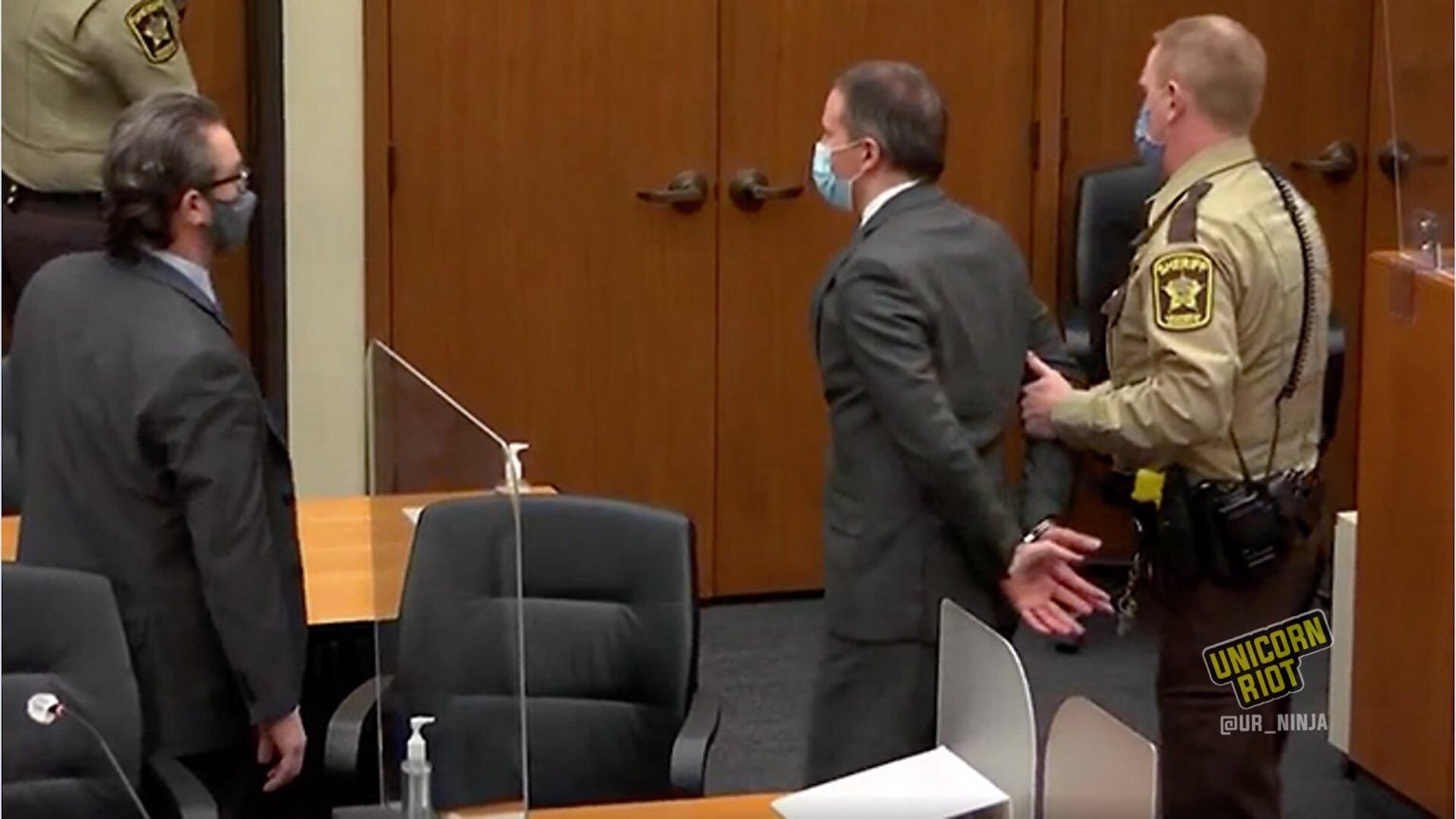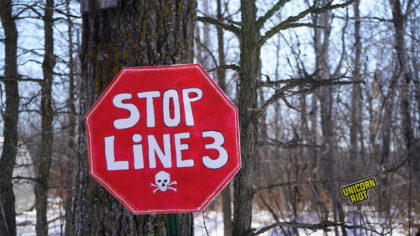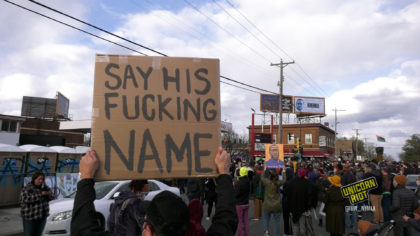Derek Chauvin Found Guilty in Murder of George Floyd
Minneapolis, MN – On Tuesday, April 20, 2021, the jury in the trial of Derek Chauvin returned a verdict finding the defendant guilty on all counts. Former Minneapolis Police (MPD) Officer Chauvin had been charged with second-degree murder, third-degree murder, and second-degree manslaughter – and now has been convicted on all 3 counts.
[To see Unicorn Riot’s court video streams and live tweets documenting all 28 days of the trial process, click here.]
Chauvin’s callous killing of George Floyd on May 25, 2020 shocked the world as bystander video showing him methodically choking the life out of Floyd went viral. MPD’s Public Information Officer John Elder (still employed by the department) added insult to injury when he whitewashed Floyd’s murder as a “medical incident.”
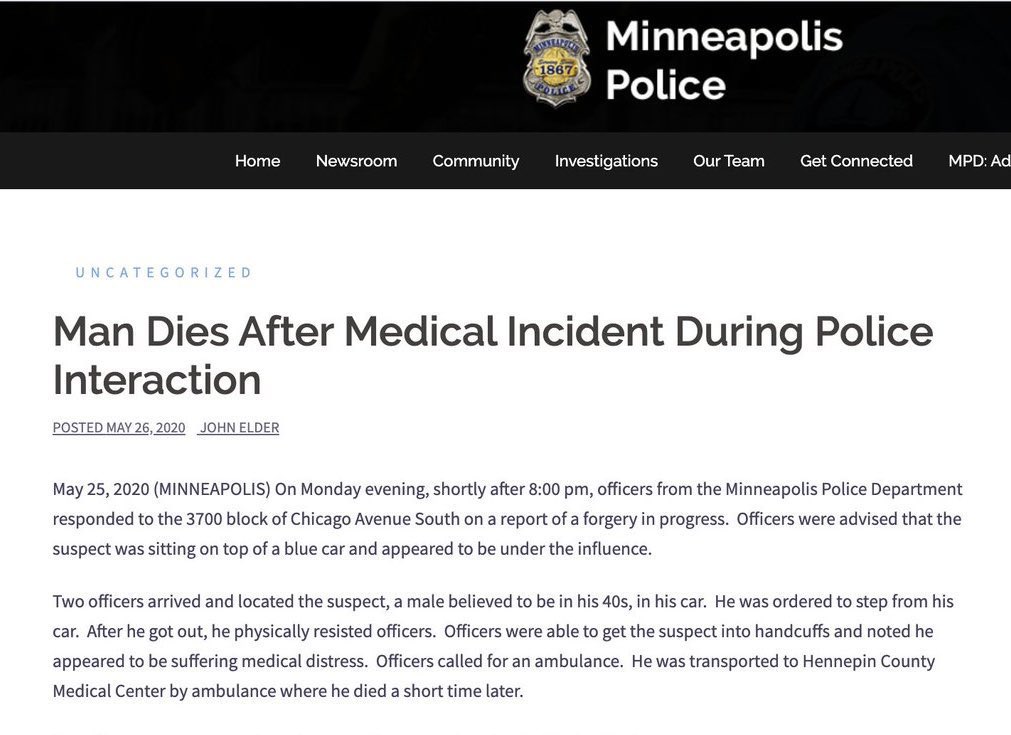
The outrage at George Floyd’s televised police lynching quickly ignited protests and militant riots across the Twin Cities and around the world. Large amounts of arson, property damage, looting and vandalism took place in the Twin Cities as it became clear Minnesota authorities were unable to contain the people’s rage. One of the demands most repeated by those out on the streets was that the officers who killed Floyd be charged with murder.
On May 29, 2020 – four days into the George Floyd uprising and one day after the Third Precinct was overrun by the community – Chauvin was arrested and charged with third-degree murder and second-degree manslaughter. (Minnesota Attorney General Keith Ellison later added on a charge of second-degree murder.) The three other officers involved in killing Floyd – Tou Thao, Thomas Lane and J. Alexander Kueng – were arrested on June 3, 2020, and charged with aiding and abetting murder. Former MPD cops Thao, Lane, and Kueng will stand trial together on August 23, 2021.
In October 2020, Hennepin County District Judge Peter Cahill sided with Derek Chauvin and dismissed the third-degree murder charge. However, in February 2021, an appeals court ordered that Judge Cahill reinstate the murder charge.
The trial officially began on March 8, 2021, with a lengthy jury selection process. Jurors were questioned closely on their thoughts about the police and the difference between a protest and a riot. Questions on the jury questionnaire included “How favorable or unfavorable are you about Black Lives Matter” and “How favorable or unfavorable are you about Blue Lives Matter?”
THE STATE OF MINNESOTA’S CASE
One element which made this trial of stand out from other cases brought against police officers was the degree of resources the state chose to invest in pursuing a successful prosecution. Attorney General Keith Ellison took a close interest in the case, and his office contracted outside high-power attorneys such as Neal Katyal to help secure a conviction. Ellison didn’t try the case personally, but was present at the prosecution’s table. Arguments and witness questioning were handled by four others from the state’s legal team – Matthew Frank, Steve Schleicher, Jerry Blackwell, and Erin Eldridge.
The roster of the state’s team was over a half-dozen people, dwarfing the courtroom presence of Chauvin’s defense, which was just Eric Nelson and his legal aide Amy Voss.
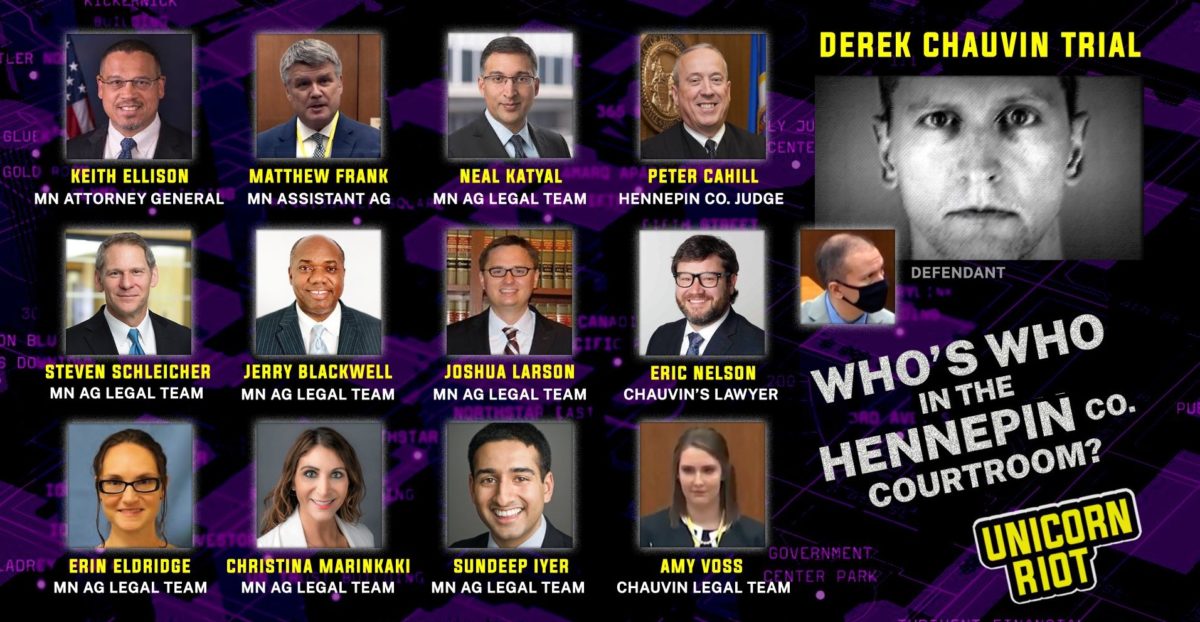
A total of 37 witnesses testified for the prosecution. A handful of eyewitnesses to the murder took the stand. Those included: Donald Williams, a mixed martial arts fighter who pleaded with Chauvin to stop the “blood choke” on Floyd, Genevieve Hanson, an off-duty firefighter who repeatedly asked officers to take Floyd’s pulse, and Darnella Frazier, who recorded Chauvin kneeling on Floyd’s neck for nearly 10 minutes.
Several paramedics, first responders and hospital staff called by the state testified about how they tried their best to save George Floyd but ultimately concluded he had no signs of life and could not be brought back. The doctor who received Floyd at the hospital before officially pronouncing him dead testified that he saw no reports indicating any sort of drug overdose.
Various forensic doctors and lab technicians testified to their analysis of blood samples from George Floyd. They repeatedly outlined how levels of fentanyl and methamphetamine, which the Chauvin defense had hoped to use to shift blame to Floyd, were far below any significant measurable levels.
The trial’s star witness was Dr. Martin Tobin, a world-renowned pulmonologist from Ireland and a medical researcher with expertise in obstructed breathing. While speaking to the jury, he showed the court numerous visual presentations, including a 3D video and dozens of graphs and slides. Dr. Tobin clearly stated that he knew that George Floyd died from lack of oxygen caused by pressure from Chauvin’s knee.
Various long-time police officers and “use of force experts” were called to testify for the state and told the court that Chauvin’s use of force on George Floyd did not appear reasonable, or in line with standard police training.
Minneapolis Police Chief Medaria Arradondo testified at length about the noble values he claimed his police department represents. Arradondo was asked about MPD training and if Derek Chauvin’s actions towards George Floyd comported with department policy – he said they did not. The prosecution showed the jury a form Chauvin signed acknowledging he had received MPD’s Policy and Procedure Manual. They then went into specific policies around use of force, which Chief Arradondo agreed Chauvin was not following in videos of the killing of George Floyd.
The state also called two witnesses close to George Floyd, including his brother Philonise who shared stories about their family growing up together. The court also heard from Floyd’s romantic partner, Courteney Ross, who described the two of them taking romantic walks and getting high together. In turns of phrase reflecting the ongoing heartbreak and tragedy of Floyd’s passing, Ross sometimes still referred to her deceased lover in the present tense.
THE DEFENSE’S CASE
Chauvin’s attorney Eric Nelson’s opening argument sought to claim that Chauvin was acting “reasonably”, was following his official police training, and/or did not know that he was killing Floyd. Nelson also sought to place blame for George Floyd’s death on various other factors such as Floyd’s history of drug use, or the alleged distraction of threat posed to Chauvin by the small crowd of onlookers who witnessed the murder.
The defense’s case was much shorter than the prosecution – calling only seven witnesses and generally questioning them for a shorter length of time.
Nelson called a former MPD officer to testify who had previously detained George Floyd in a car at gunpoint and arrested him. The defense presumably hoped the footage of this May 2019 incident would paint Floyd in an unflattering criminal light. It appeared to be counter-productive as it ultimately emphasized why Floyd panicked the way he did when Officer Lane approached him with a gun drawn, yelling and cursing, on May 25, 2020.
Two of the defense witnesses from the ‘police expert’ circuit ended up offering revealing insight into the racist history (and present) of policing institutions.
One notable defense witness was Barry Brodd, a retired cop who came up in the 1970s and a former use of force consultant for the San Francisco District Attorney’s office. Brodd proudly told the court about his role in crafting a “verbal judo” program for officers, “developed after the Rodney King incident…to overcome a person’s potential non-compliance.” Brodd said he “felt that Derek Chauvin was justified, was acting with objective reasonableness” and was following department policy. After his testimony, a pig’s head and blood were found at a San Francisco home where Brodd recently lived – likely left under the impression that Brodd still lived there. The police department in Santa Rosa, CA, where Brodd once worked as an officer, quickly issued a statement claiming that “[Mr. Brodd’s] comments do not reflect the values and beliefs of the Santa Rosa Police Department.“
The most alarming witness called by the defense was Dr. David Fowler, a former medical examiner for the State of Maryland. Fowler, who is white, received his medical training in apartheid South Africa before moving to the U.S. to work for American police. Fowler’s previous work for Maryland is the subject of a lawsuit brought by relatives of Anton Black, whose family say Fowler helped cover up his death. Fowler insistently told the court that Floyd did not die from Chauvin’s actions and that the officer acted properly.
THE VERDICT
A verdict was reportedly expected on Wednesday but arrived earlier, on Tuesday afternoon. The jury foreperson told Judge Cahill that they had found the defendant guilty on all three counts. Judge Cahill then granted the state’s motion to revoke Chauvin’s bond – the former MPD officer was then handcuffed and taken into custody live on camera for the whole world to see. Chauvin has reportedly been placed on suicide watch since being incarcerated pre-sentencing.
Chauvin’s conviction represents a victory for those seeking justice for George Floyd, yet for many, the ‘win’ rings hollow and feels incomplete. It also raises a paradox for the protest movement that sprung up after Floyd’s murder, which elevated calls for the total abolition of the police. Much of the testimony presented by the state of Minnesota, particularly through police witnesses like Chief Arradondo, seemed intended to wipe up the soiled reputation of law enforcement in general. To many, it appeared that the police department at large was sacrificing Chauvin to save themselves.
The day after the verdict, in an ‘Operation Safety Net’ press conference, state and local police indicated they would begin to demobilize the military occupation they imposed on the Twin Cities in anticipation of a popular revolt.
Follow us on X (aka Twitter), Facebook, YouTube, Vimeo, Instagram, Mastodon, Threads, BlueSky and Patreon.
Unicorn Riot's Derek Chauvin Trial Coverage:
- Continued Coverage of the Derek Chauvin Trial
- Derek Chauvin to be Moved to Federal Prison After Sentenced to 21 Years - July 7, 2022
- Ex-Cop Derek Chauvin Sentenced to 22.5 Years for George Floyd Murder - June 25, 2021
- The State’s Conviction of Chauvin Upholds the System’s ‘Innocence’ - April 25, 2021
- Derek Chauvin Found Guilty in Murder of George Floyd - April 22, 2021
- Race and Perception: First Two Weeks of Derek Chauvin Pre-Trial - March 21, 2021
- Black Lives Matter & Blue Lives Matter at Center of Jury Questionnaire - March 11, 2021
- Chauvin Has 3rd Degree Murder Charge Dropped, 2nd Degree Charges Upheld - October 23, 2020
- Ex-Cop Charged in George Floyd Murder Out On $1M Bail - October 7, 2020
- Pretrial Begins: County Attorney Freeman Pulled from George Floyd Police Prosecutions - September 14, 2020
- New Footage Reveals Moments Before George Floyd’s Death - May 30, 2020
- Minneapolis Police Murder Handcuffed Man With Neck-Kneel - May 26, 2020
Unicorn Riot's George Floyd Coverage:
- George Floyd Uprising – Reporter Reflection [5 Episode Series] - Fall 2020
- Beyond the Barricades: A Look At George Floyd Square [Mini-Doc - March 2021]
- Fourth Killer of George Floyd Found Guilty - May 3, 2023
- Two Years After George Floyd - May 27, 2022
- One Year After George Floyd in Europe: Afro-Greeks and African Migrants Speak Out [Videos] - February 17, 2022
- Judge Cahill’s No-Knock Warrant Led to MPD Execution of Amir Locke - February 8, 2022
- Caravan for George Floyd as Federal Trial Begins for Officers Lane, Kueng, and Thao - January 22, 2022
- One Year After George Floyd in Europe: The Deep Roots of Racism in Germany [Video] - October 11, 2021
- Minneapolis Pushes Activists to Their Limits - July 22, 2021
- Ex-Cop Derek Chauvin Sentenced to 22.5 Years for George Floyd Murder - June 25, 2021
- Community Gathers at George Floyd Square After City Removes Concrete Barriers - June 3, 2021
- The State’s Conviction of Chauvin Upholds the System’s ‘Innocence’ - April 25, 2021
- Derek Chauvin Found Guilty in Murder of George Floyd - April 22, 2021
- Derek Chauvin Trial Coverage Landing Page - 2021
- George Floyd Square Celebrates Malcolm X - March 2, 2021
- Jay Kolls: False Reporting From George Floyd Square to D.C. - January 23, 2021
- Minneapolis Police Violently Assault Man Yards From George Floyd Memorial - December 23, 2020
- Behind the Law Enforcement Response to the George Floyd Uprising – Pt 1: Munitions Delivery - December 3, 2020
- Pawn Shop Owner Faces No Charges in Killing Man, State Blames Protesters - November 8, 2020
- Feds Leverage Civil Disorder Charge Against George Floyd Protester - November 1, 2020
- Minneapolis Protest Art Collection Becomes Largest of its Kind - October 28, 2020
- Chauvin Has 3rd Degree Murder Charge Dropped, 2nd Degree Charges Upheld - October 23, 2020
- Youth Lead March After Ex-Cop Charged in Floyd’s Murder Bailed Out - October 14, 2020
- Ex-Cop Charged in George Floyd Murder Out On $1M Bail, Dozens Arrested in Protest - October 7, 2020
- Pretrial Begins: County Attorney Freeman Pulled from George Floyd Police Prosecutions - September 14, 2020
- “No Justice, No Street" – Community Makes Demands, Eviction of George Floyd Memorial Square Delayed - August 17, 2020
- George Floyd Uprising in Minneapolis–Saint Paul — The First Two Weeks - June 14, 2020
- Denver Police Served Temporary Restraining Order Amid Nationwide Protest Repression - June 11, 2020
- Nine Council Members Vow to Disband Minneapolis Police - June 10, 2020
- Rally and March to Defund MPD after George Floyd: Day 12 - June 6, 2020
- George Floyd Memorial Service in Minneapolis - June 4, 2020
- Action at WCCO to End Media Bias Against Victims of Police Violence: Day 9 - June 3, 2020
- Owner Assaulted by Troopers While Protecting His Business - June 2, 2020
- Minneapolis Protests Police Murder of George Floyd: Day 7 - June 1, 2020
- New Footage Reveals Moments Before George Floyd’s Death - May 30, 2020
- Twin Cities Protest Death of George Floyd: Day 3 - May 28, 2020
- Minneapolis Protests Police Murder of George Floyd: Day 2 - May 27, 2020
- Minneapolis Police Murder Handcuffed Man With Neck-Kneel - May 26, 2020
